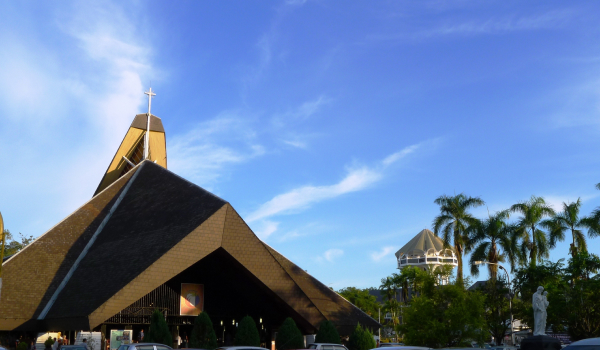
The Archdiocese of Kuching is located on the north-western part of the island of Borneo- in the Malaysian state of Sarawak. When it became an archdiocese in 1976 it covered the Kuching, Samarahan, Sri Aman and Betong Divisions of Sarawak comprising the city of Kuching and the towns of Bau, Lundu and Serian. It is the smallest of the three dioceses in Sarawak, covering an area of 19,174.4 square kilometers or 15 percent of Sarawak's territory.
Population The archdiocese's population is made up of Chinese, Malays, Ibans, Indians and other ethnic groups. The Dayaks, the grouping of local indigenous tribes, can be categorized into Ibans, Bidayuhs, Melanaus and Orang Ulu, among others.
A majority of people in Kuching are capable of communicating in Bahasa Melayu (Malay Language) and English. English is widely spoken in Kuching. The dialect of Malay spoken in Kuching is known as Bahasa Sarawak (Sarawakian Malay Language), which has lexical differences with the dialect spoken in Peninsular Malaysia.
On top of Malay and English, Kuchingites can usually speak his or her own ethnic dialect or language. An Iban can speak Iban, a Bidayuh can speak Bidayuh and the Chinese usually several Chinese dialects, the most common being Hokkien and Mandarin in Kuching. More recently, it has been argued that Mandarin has become more widely spoken than Hokkien since it is well known by other Chinese and is the language of instruction in Chinese vernacular schools. For the Bidayuhs, the dialect of Bidayuh spoken in one kampung/village may vary greatly with another kampung/village. It is also common to find people who can speak more than just Malay, English and their native tongue, not only due to the wide practice of mixed marriages but because of the close rapport amongst the people of Kuching.
Sarawak was a part of the Sultanate of Brunei 200 years ago but as a reward for help in putting down a rebellion, it was ceded to the British adventurer James Brooke who ruled it as his personal kingdom. Kuching was made his capital and headquarters. The Brooke Administration was given the status of Protectorate under Rajah Charles Brooke's rule and was placed behind the Indian Rajs and Princes. The Brooke family ruled Sarawak until the Japanese occupation in December 1941.
Kuching was surrendered to the Japanese forces on Dec. 24, 1941, and Sarawak was part of the Japanese Imperial Empire for three years and eight months, until the official Japanese surrender on Sept. 11, 1945, on board HMAS Kapunda at Kuching. From March 1942 the Japanese operated a POW and civilian internee camp at Batu Lintang, three miles (5 km) outside Kuching.
After the end of World War II the third and last Raja, Sir Charles Vyner Brooke ceded Sarawak to the British Crown in 1946. Sarawak and the British Commonwealth fought an "Undeclared War" with Indonesia to keep Sarawak from being absorbed into Sukarno's Indonesia. The British gave Sarawak independence in 1963 and together with North Borneo (now Sabah) and Singapore, helped form Malaysia on Sept. 16, 1963. Singapore became an independent nation in 1965.
Kuching is home to Universiti Malaysia Sarawak. The university now has two campuses. The old campus in Kuching is known as the East Campus, while a new campus to be called the West Campus is currently under development. The West Campus is located in a new township called Kota Samarahan.
Swinburne University of Technology Sarawak Campus is also located in the city. The university offers courses in IT, engineering and business.
The main religions of the citizens are Christianity, Buddhism, Taoism and Islam. Malays practice Islam and all Malays are Muslim by definition. The Chinese practice either Buddhism, Taoism or Christianity. Most Dayaks are Christian, with the exception of the Melanaus, who are partially Muslim.
There is also a state mosque, Christian churches and Chinese temples. It has one of Asia's finest museums with an excellent collection of Borneo's ethnological and archaeological artifacts.
The district of Kuching is administered and divided into three local governments, which are namely DBKU (Kuching North City Hall), MBKS (Kuching South City Council) and MPP (Padawan Municipal Council).
The area north of the Sarawak River, parts of Old Kuching, Satok and the western Central Business District (CBD) is within the jurisdiction of Dewan Bandaraya Kuching Utara (Kuching North City Hall) covering an area of 369.48 square kilometres (142.66 square miles). Kuching North City Hall is directly under the supervision of the Chief Minister of Sarawak. The area south of the Sarawak River, eastern CBD and towards the South China Sea is within the jurisdiction of Majlis Bandaraya Kuching Selatan (Kuching South City Council), covering a smaller but more densely populated area of 61.53 square kilometres (23.76 square miles).
There are those who believe that the divisions in power for the Northern (primarily Malay and Bumiputera residents) and Southern (primarily Chinese residents) districts came about due to ethnic reasons in the 1980s. There are also those who believe the administration is divided due to geographical reasons, as the Northern and Southern districts are linked by only three bridges spanning the Sarawak River.
The third local government is Majlis Perbandaran Padawan or Padawan Municipal Council, formerly known as the Kuching Rural District Council (Majlis Daerah Luar Bandar Kuching), which administers the rural areas within Kuching district, Batu Kawa, Kota Sentosa and Third Mile. It covers a large portion of Kuching district with an area of 1,431.82 square kilometres (552.83 square miles).
Kuching is home to the New Sarawak State Legislative Assembly Building which was recently completed. It is located at the bank of the Sarawak River and is one of the latest landmarks of the city.
A new federal administrative centre in Matan